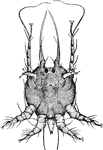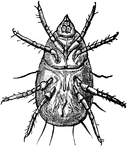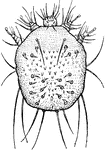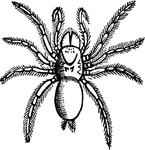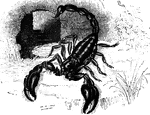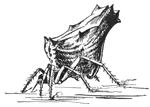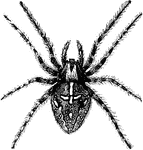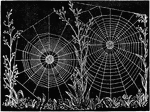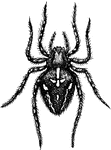The Spiders, Mites and Scorpions ClipArt gallery includes 149 illustrations of spiders, mites, scorpions, and other members of the arachnid class.

Liphistius Desultor
"Liphistus desultor, Ventral view with the prosomatic appendages cut short expecting the chelicerae…

Liphistius Desultor
"Liphistius desultor. Lateral view. I to VI, Appendages of the prosoma cut off at the base. o, Ocular…

Liphistius Desultor
"Liphistius desultor. Under side of the uplifted genital or first opisthosomatic somite of the female;…

Megalaspis
"Megalaspid extenuatus. One of the Asaphidae allied to Illaenus, from the Ordovician of East Gothland,…
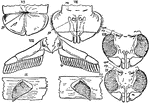
Mesosomatic
"The first three pairs of mesosomatic appendages of Scorpio and Limulus compared. VII. The genital operculum;…
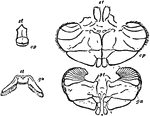
Meta-sternite
"Diagrams of the meta-sternite st, with genital operculum op, and the first lamelligerous pair of appendages…
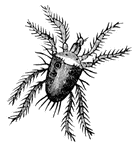
Mite
The mites form with the ticks the order Acarina, and are distinguished by the fact that the abdomen…
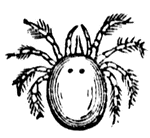
Mite
The mites form with the ticks the order Acarina, and are distinguished by the fact that the abdomen…
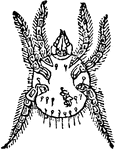
Cheese mite
"Of the true mites, the domestic or cheese mite and the itch-mite are examples." — Williams, 1889

Harvest Mite
The harvest mite or chigger (Leptus autumnalis) is a mite that live in forests and grasslands.

Cotton Rust Mite
The cotton rust mite (Tetranychus gloveri) is a spider mite known for causing damage to cotton leaves.

Mygale
"The spiders with which we in temperate climates are most acquainted are of small size, but in hot regions…

Nymphonomorphous
"One of the Numphonomorphous Pantopoda, Nymphon hispidum, showing the seven pairs of appendages 1 to…

Palaeophonus Hunteri
"Ventral view of a restoration of Palaeophonus Hunteri, Pocock, the Silurian scorpion from Lesmahagow,…

Palaophonus
"Dorsal view of a restoration of Palaeophonus nuncius, Thorell. The Silurian scorpion from Gothland."…

Phrynidae
A species of Phrynus, actual size. The species resembles spiders with long feelers and great claws.
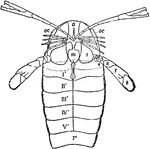
Pierygotus Osiliensis
"Pierygotus osiliensis, Schmidt. Silurian of Rootzkil. Restoration of the ventral surface, about a third…

Prosomatic Limb
"Comparison of the sixth prosomatic limb of a recent scorpion (B), of Palaeophonus (C), and of Limulus…

Retinula
"Diagram of a retinula of the central eye of a scorpion consisting of five retina-cells (ret), with…
Rhabdom
"Rhabdom of the same, consisting of five confluent rhabdomeres." — The Encyclopedia Britannica,…

Rhabdom
"Transverse section of the rhabdom of a retinula of the scorpion's central eye, showing its five constituent…
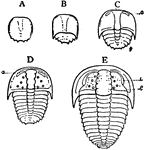
Sao Hirsuto
"Five stages in the development of the trilobite Sao hirsuta. A, Youngest stage. B, Older stage with…

Schizomus
"Schizomus crassicaudaius, one of the Tartarid Pedipalpi. Ventral view of a female with the appendages…
Schizomus
"Schizomus crassicaudatus, a Tartarid Pedipalp. Dorsal view of a male with the appendages cut short.…
Schizomus
"Schizomus crassicaudatus, one of the Pedipalpi. Lateral view of a male, II to VI, the prosomatic appendages,…

Scorpio Embryo
"Embryo of scorpion, ventral view showing somites and appendages. sgc, Frontal groove. sa, Rudiment…

Scorpion
Scorpions are found in warm climates, reaching their greatest size in tropical America and Africa.

Scorpion
Scorpions are characterized by having a distinctly segmented abdomen, which passes into the cephalothorax,…

Scorpion
The name of an extensive genus of insects, native to the warm climates of both hemispheres, and belonging…

Scorpion
"Ventral view of a scorpion. Palamnaeus indus, de Geer, to show the arrangement of the coxae of the…

Scorpion
"View from below of a scorpion (Buthus occitanus) opened and dissected so as to show the pericardium…
Scorpion
"Diagram of a lateral view of a longitudinal section of a scorpion. d, Chelicera. ch, Chela. cam, Camerostome.…
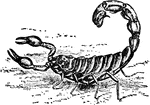
Scorpion
"Drawing from life of the desert scorpion, Buthusaustralis." — The Encyclopedia Britannica, 1910

Scorpion
"Drawing from tlife of the Italian scorpion Euscorpius italicus, Herbst, holding a blue-bottle fly with…

Scorpion
"The same scorpion carrying the now paralysed fly held in its chelicerae, the chelae liberated for attack…

Scorpion Diagram
"Diagram of structure of Scopionidae (most of the appendages removed). IV. to XX., fourth to twentieth…

Scorpion Eyes
"Development of the lateral eyes of a scorpion. h, Epidermic cell-layer; mes, mesoblastic connective…

Black Rock Scorpion
The Black Rock Scorpion (Scorpio (Buthus) Afer), "seen from above. At, the chelicerae, or chelate antennae;…

Dorsal View of Sea Scorpion
The dorsal view of Eurypterus remipes, an extinct sea scorpion from the Silurian period.
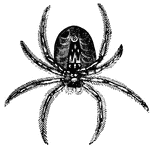
Spider
A Spider's spinning apparatus is peculiar. A reservoir inside contains gummy matter from which silk…

Spider
An extensive division of insects, which includes the scorpions and mites. The spiders differ from most…

Spider
"Bird-catching Spider, a name originally given to a large spider, Mygale avicularia, a native of Cayenne…

Spider
"Ventral view of a male mygalomorphous spider. I to VI, The six pairs of prosomatic appendages. a, Copulatory…
